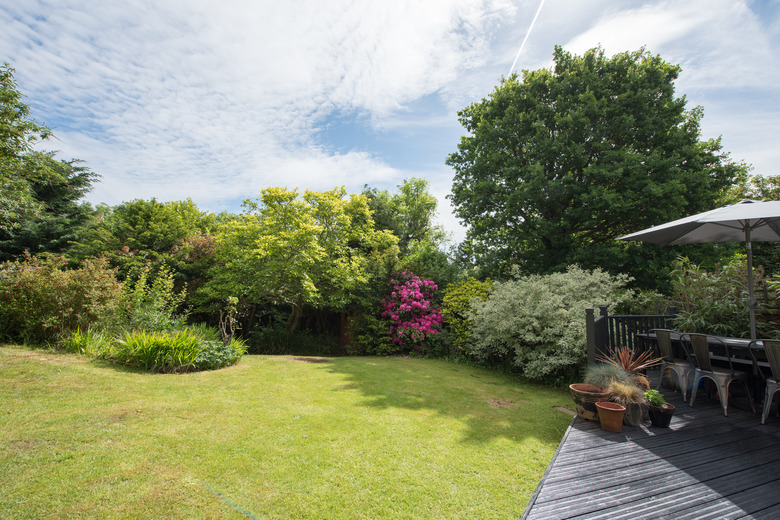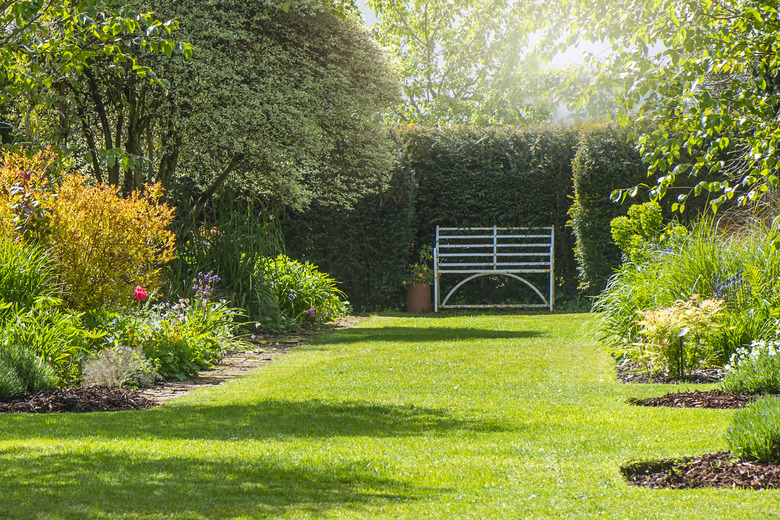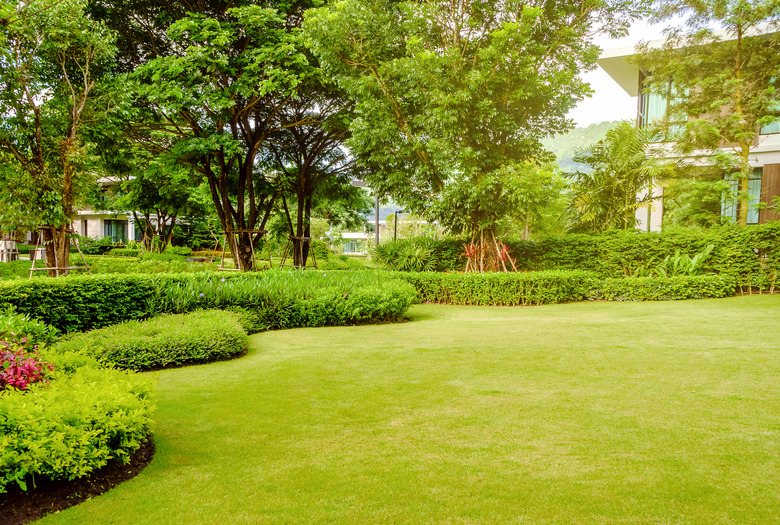How To Grow A New Lawn With Grass Seed
We may receive a commission on purchases made from links.
There are several ways to create a new grass lawn, but the least expensive and least labor-intensive is to sow grass seed onto the soil of a prepared site and tend it until it grows into a thick lawn. It can take several weeks to establish a perfect lawn using this method, but it is far easier and less expensive than laying rolls of sod.
The actual work of planting a new lawn using grass seed is relatively simple, but there are planning steps to consider. These steps are fairly easy if you are just replacing grass on an existing site where old grass has been killed off or removed, but it can be more complicated if you are planting a new lawn where none existed before, such as when finishing the landscaping for a newly built home.
Completing the Hardscape
Completing the Hardscape
If you are renovating an old lawn, then you may not need to complete any hardscaping work before preparing to sow grass seed. It's likely that the hardscape work has already been completed. However, if you are seeding a brand-new site, then you should make sure to complete these projects before turning to the lawn. It's much easier to complete this construction work before the grass starts to grow.
This work can include installing an underground sprinkler system, installing sidewalks and walkways, installing edging materials to define planting areas and installing any kind of patio or decking that the landscape requires. In some cases, it may require some fairly major earth-moving work, such as building retaining walls and terracing the lawn area or building a pond or other water feature. All this work should be done before you turn to seeding the new lawn.
Scheduling Seeding a New Lawn
Scheduling Seeding a New Lawn
The best time for planting a new lawn using grass seed depends on the region where you live. For Northern lawns that use cool-season grasses, sowing grass seed can be done in fall or spring. Planting cool-season grasses in the heat of summer will likely lead to failure, as these grass species don't germinate well in high temperatures.
For Southern lawns where warm-season grasses are the norm, the best time for sowing grass seed is late spring and summer. These grass species require warm temperatures in order to germinate.
Choosing Grass Seed
Choosing Grass Seed
You have several choices when you decide to sow grass seed for your new lawn. First, turfgrasses are divided into cool-season and warm-season species. Cool-season grasses include species such as Kentucky bluegrass, perennial ryegrass and various fescues. These grasses stay green down to 32 degrees Fahrenheit and will be hardy through the winter in climates with freezing winter temperatures.
Warm-season grasses includes species such as zoysia, centipede or Bermudagrass. They grow quickly in the summer and prefer temperatures between 80 and 90 degrees. Warm-season grasses are not hardy in cold-winter climates. In transitional climates where summer temperatures are quite hot but winter temperatures are relatively cold, Bermudagrass and tall fescue are the most common choices for this type of grass.
Getting the right grass seed is usually easy if you purchase it from a local garden center since it will stock only the grasses appropriate for your region. A knowledgeable clerk will usually steer you to the right grass seed for your application. When you purchase from online retailers, make sure you are buying seed that is well-suited for the climate in your region.
It's relatively rare to plant a lawn using a single grass species. Most commercial seed products are blends of different grasses. This is designed to maximize the performance of the lawn seed over a range of conditions. For example, one typical cool-season grass blend includes perennial ryegrass that does well in full sun, Kentucky bluegrass that spreads well and has good color and several fescue species that do well in shadier conditions. By including several types of seed in the same mix, manufacturers ensure that most homeowners will have success with the product.
Grass seed manufacturers also offer a variety of targeted blends of grass seed. For example, you can buy "shady mix," "sunny mix" or "high-traffic mix" blends. Each of these offers a blend of different grass species known to perform well in specified conditions.
Of course, you can also buy seed from one species only if you want a truly uniform-looking lawn. Large garden centers may stock bulk grass seed by species for this purpose. There is some danger to this approach, as a pure-species lawn may be ruined if a single pest or disease that favors your grass species decides to invade.
Testing the Soil
Testing the Soil
Like most plants, grass does best in a loamy soil with a balance of nutrients and a relatively neutral pH level. In the case of turfgrass, most species prefer a pH level between 5.8 and 7.2 and a soil that is fairly high in nitrogen, but it is entirely possible that your lawn site does not match these perfect conditions.
To ensure good performance for your new lawn, conduct a soil test on your lawn site before planting. Soil test analysis can be done for a nominal fee through your county extension service or by using a soil test kit. The best analysis will be obtained by sending the sample to a laboratory, which will send you back a report that details precisely what nutrient deficiencies and excesses are found in your soil and how to correct them.
Things Needed
-
Lawn soil or topsoil (if needed)
-
Lawn starter fertilizer (optional)
-
Power tiller (if needed)
Sowing Grass Seed for a New Lawn
1. Preparing the Planting Area
A turfgrass lawn will be easier to maintain if it is relatively flat or at most, gently rolling. Achieving this may involve hauling in extra soil to fill low spots or lowering high areas by raking to create a planting area that is more-or-less flat. The planting site can be sloped — in fact, in some cases it's advantageous for the lawn to slope to improve the drainage — but all major lawn maintenance chores will be easier if the lawn is relatively flat over large sections.
Tip
On lawn sites with steep slopes, you might want to consider major hardscaping work to terrace the lawn using one or more retaining walls to create large, flat areas of lawn that will be easier to mow.
2. Amending the Soil
Based on soil test recommendations, you may need to change the soil texture or chemical makeup to make it more ideally suited for growing grass. Your local university extension service or an independent lab can provide instructions for how to take a soil sample, followed by a written report that details the type and application rate of amendments you should add to the seeding site. For example, the soil report may recommend blending in powdered sulfur to lower the pH on soil that is very alkaline, moving it into the neutral range that is ideal for growing grass.
Further, you may find it necessary to simply add some soil to the seeding site. For example, if the site is excessively sandy or if it is highly compacted with a high clay level, it may require the addition of quite a lot of good topsoil before growing a good lawn is practical. If you are doing this, it's best to buy soil in bulk from a local landscape center and have it delivered by truck. If the amendment needs are less dramatic, then bags of topsoil purchased from a home improvement center can be spread over the lawn site.
While it's possible to use ordinary topsoil to amend the soil, several lawn seed manufacturers offer lawn soil blends that contain a mixture of sterile, weed-free topsoil and compost. This makes for an excellent soil amendment, improving the texture of the soil while also improving its nutrient level.
Spread whatever amendments you are using over the seeding site just before you're ready to seed. Blend them into the existing soil with a tiller or by using a shovel and rake to dig and turn over the soil over the entire seeding site.
3. Preparing to Seed
Getting ready to seed requires that you create a fine-textured layer of loose, porous soil that is several inches thick and is free of stones, clumps, sticks and any other debris. If the site is lumpy with soil clods or is highly compacted, use a tiller to churn up the lawn area followed by a vigorous raking with a stiff bow rake. Clumps of soil can be broken up by striking them with the face of the rake. Soil clumps should be no larger than the size of a pea or marble, then use a garden rake to lightly rake off any remaining debris from the surface of the planting site.
4. Spreading Fertilizer (Optional)
While it's standard practice not to fertilize a new lawn seed for several weeks until plenty of new growth is established, seed manufacturers now offer several fertilizer products designed for gentle feeding of germinating grass plants. These products are normally spread over the lawn with a push spreader and can be laid down either before or after the seeds are spread.
Begin with the perimeter of the lawn area and then work your way across the entire lawn in parallel passes. Take care not to overlap passes since this will dump too much fertilizer on the overlapping bands, which runs the risk of burning the newly sprouting grass plants.
Tip
Some grass seed products will specifically advise against fertilizing at the time of planting. Always read label directions for advice on when and how to fertilize new grass.
5. Sowing the Grass Seed
Using a spreader, broadcast the grass seed over the lawn area. Make sure to set the spreader for the density recommended by the seed manufacturer. Seeding too densely can make it hard for seeds to germinate and take root; if it's too sparse, your lawn may take many months to fill in and become lush.
Begin by seeding the perimeter of the lawn and then cover the entire lawn with back-and-forth passes with the spreader similar to how you mow a lawn. The passes should overlap just slightly to ensure that all areas are covered.
6. Covering the Seed With Soil
Now, cover the seed with a thin layer of topsoil or lawn soil blend. A bare layer of about 1/4 inch is all that's required. Once soil is sprinkled over the seeded lawn, lightly rake it to embed the seeds in the soil. Immediately dampen the entire area to hold the seed in place by using the misting setting on a water wand or using a sprinkler.
7. Applying Mulch Over the Seeded Area
To help keep the seeds in place so they're not washed away or eaten by birds, apply a thin layer of mulch over the seeds. Weed-free wheat straw is a good choice, because not only does it protect the seeds but it decomposes in place without having to rake it away when the grass is established. A rule of thumb is to use 1 bale of straw per 1,000 square feet.
8. Watering the Seeded Area
Keep the seeded area moist but not soggy over the next few days until the grass seeds sprout. Germination usually occurs within seven days, but some types of grass may take as much as 30 days under some conditions. Proper care requires watering at least every day and possibly two or three times a day on hot, windy days. The goal is to keep the top 1 inch of soil consistently moist.
Once the seeds germinate and the grass begins to grow, begin to water more deeply at least once a week, moistening the soil down to a depth of at least 2 inches. Avoid foot traffic on the new grass for a few weeks until the grass plants are well-established.
9. Caring for the New Lawn
Do not mow your new lawn until the grass blades have reached at least 3 inches in length. At this point, you can begin a normal lawn maintenance routine, cutting off no more than 1/3 of the length of the grass blades at each mowing. After six to eight weeks, routine seasonal fertilization can occur at whatever intervals are recommended by the grass seed manufacturer and your local lawn experts.


